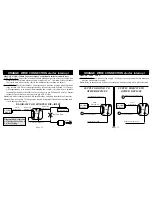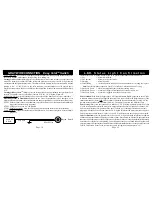
Page
Page
-10
-11
L.E.D. S t a t u s L i g h t C o n f i r m a t i o n
The Red status L.E.D. light will inform you of 14 possible conditions the alarm can be in:
1) Off
= Alarm is Disarmed.
2) On Constant
= Alarm is in the valet mode.
3) Flashing
= Alarm is armed.
4) Fast Flashing
= 30 second passive arming or 90 seccond automatic re-arming in progress.
Note: The flash & pause sequences 5 thru 7 are for Zone Violation and Zone Testing.
5) Flash-1x & Pause
= Alarm was triggered from the current sensing circuit.
6) Flash-2x & Pause
= Alarm was triggered from the hood or trunk circuit wire.
7) Flash-3x & Pause
= Alarm was triggered from the door circuit wire.
Zone Violation: If the alarm is triggered the L.E.D. light will start to flash & pause the #5 thru #7 code
to indicate what protected circuit triggered the alarm. This code is held in the alarm's memory if the
alarm automatically re-arms and after the alarm is disarmed from the transmitter. Turning "on" the
ignition clears the code from the alarm's memory. The memory can store two different codes.
Zone Testing: Every time the ignition key is turned off , L.E.D. light will flash & pause the #5 thru
#7 code to indicate what protected circuit is in a triggered state. Example: Open a door and the L.E.D.
light will start flashing 3x & pause until the door is closed, or, if another protected entry point is
triggered while the door is still open, then the L.E.D. light will indicate the most recent zone triggered.
Current sensing can only detect a "spike", so the L.E.D. will flash once only during a current spike.
Code Verification: After the ignition is turned on, the L.E.D. light will flash to indicate the number
of transmitters programmed to operate your alarm system. For example: two flashes & pause indicates
that only two transmitters are coded to operate your system. When you leave the alarm installation shop
or retrieve the vehicle after valet parking, you will now have the peace of mind of knowing that only
your transmitters will operate the alarm and that no additional transmitters have been coded to steal your
vehicle. This feature works for 10 seconds every time the ignition switch is turned "on".
E a s y
V a l e t
TM
B u t t o n S w i t c h
VALET FUNCTION: Easy Valet
TM
is designed to keep the alarm from arming during extended
stopovers for service stations, maintenance, valet parking, car washing, etc.
Turning On Easy Valet
TM
: This unique feature can be activated anytime the alarm is in the disarmed
condition. Easy Valet
TM
is unique because other alarms require the ignition to be turned "on", but with
this system, the ignition can be either "on" or "off".
Simply press the valet button switch for two seconds to activate the valet mode. The alarm will
confirm it is in the valet mode with two siren chirps, the L.E.D. light coming on constant and the lights
flashing twice. The alarm will hold memory of the valet condition while the ignition is "on" or "off".
While in the valet condition, the transmitters can still operate panic, doorlocks, trunk release; the doors
will lock when the ignition is turned "on" and unlock when turned "off"'.
Turning Off Easy Valet
TM
: Simply press the valet button switch and instantly the valet feature will
turn off. To confirm that the valet mode is turned "off", the L.E.D. light will turn off.
OVERRIDE FUNCTION:
Disarming Alarm If Transmitter Is Lost: In the event the transmitter is lost, damaged, or its
batteries become exhausted, the valet button switch and your ignition key can disarm the alarm system:
STEP 1. With the alarm in the armed condition, enter via the driver's door (be aware that the alarm will
trigger the instant the door is opened).
STEP 2. Using your key, turn "on" the ignition.
STEP 3. Within 10 seconds, push the valet button switch and the alarm will disarm instantly.
NOTE: The Easy Valet
TM
button switch is part of the programing operations for learning new
transmitter codes and for changing system functions. These operations are explained in detail
in subsequent pages.







































